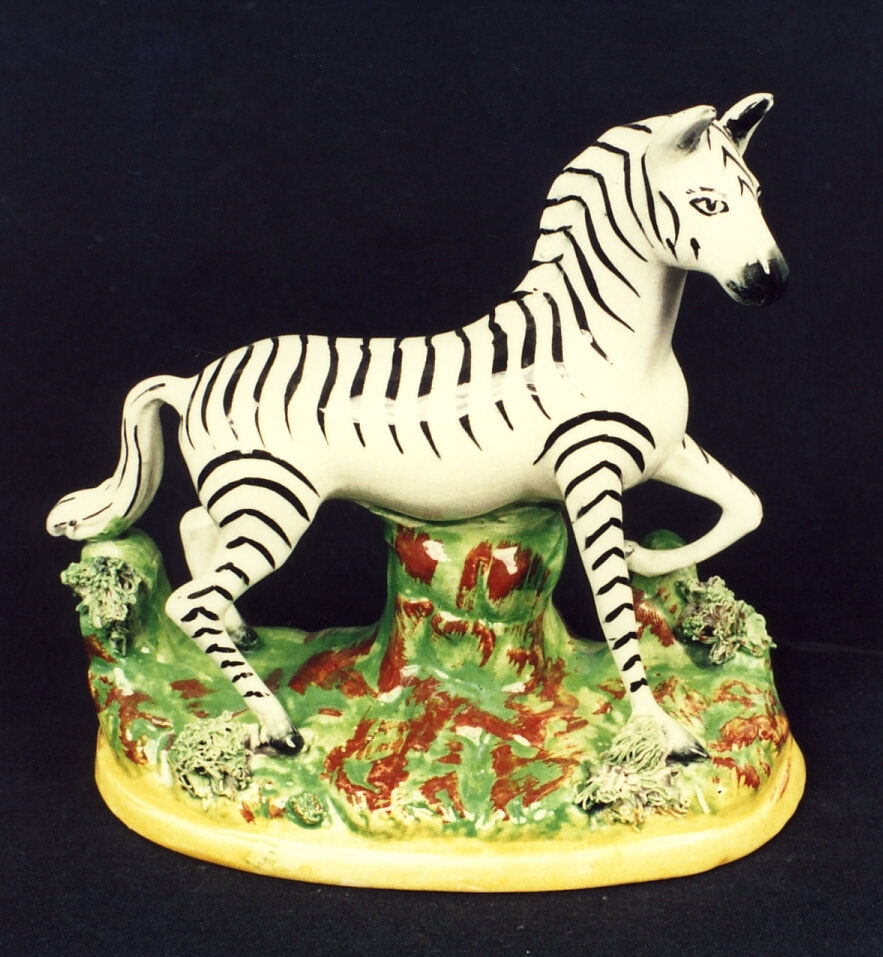STAFFORDSHIRE STORY: ZEBRAS

STAFFORDSHIRE STORY: ZEBRAS
By Marguerite Bell
The first zebra brought to England arrived in 1762 and was kept in the menagerie at Buckingham House (Palace), ‘companioned by an elephant, and later on transferred to the Tower of London’
An observer noted “the Queen’s she-ass was pestered with visits, and had all her hours employed from morning to night in satisfying the curiosity of the public. She had a sentinel and guard placed at the door of her stable. The crowds that resorted to the asinine palace were exceeding great.” It, like all sorts of other wild animals, real and imaginary fascinated both the general public and possibly the Staffordshire potters who modelled them.
In fact, ‘the range of wild animals [they] made would do justice to a small zoo’ writes Kit Harding, but, of course, the craftspeople may never have seen a zebra except perhaps at a zoo, a circus or a travelling menagerie. Harding also says that ‘the resulting representations are quite superb in their accuracy’, allowing, of course, for tails that are more like those of horses and stylised regular narrow black stripes.
There are several versions of zebras in The Johnston Collection and like many Staffordshire animals were possibly originally made in pairs to decorate a mantelpiece. They appear designed to be viewed from one side only and with minimal decoration on the reverse. Two pieces face each other; one looking to the right, the other to the left and are dated circa 1860-70 (A0339-1989), (A0346-1989). They are not a pair but each stands with a foreleg raised, the body supported on a trunk-like feature with an applied bocage decoration on the base and each is similar but again not exactly identical to many zebra pieces.
Another zebra figurine is a spill vase, circa 1860-70 (A0562-1989) and is described as facing to the right, its left foreleg raised and resting on an outcrop, the tree trunk forming the spill holder. There is applied bocage decoration and a gilt line around the base, and stylised stripes on the animal’s body. Spill vases were used for storing wax tapers, or cheaper twisted sheets of paper ‘spills’, with which fires or candles could be lighted. Interestingly, there is another similar spill vase with a horse figure which is made from the same mould as the zebra but painted with stylised ‘piebald’ red markings (A0287- 1989). The same red paint appears to have been used for the tree trunk behind the zebra and for the patches on the horse. Horse or zebra? The differences do not appear to have concerned the potter.
The final piece a figure group, circa 1850, (A0427- 1989) is of a young girl mounted on a zebra side-saddle fashion, not that zebras have ever been domesticated to be beasts of burden or to carry riders. The zebra is prancing along and faces to the left whilst the rider looks at the viewer. She is wearing a hat, a dress with pink petticoats and is holding the reins, painted in yellow, in her hand. Like the zebras mentioned previously, it is likely that she also was one of a pair with a male companion who faces right.
When William Johnston was aged about 11, he acquired his first Staffordshire zebra. Whether one of the pieces in the collection is that particular one, is not known but it was certainly the first of many such pieces that we can enjoy at Fairhall today.
This article was first published in fairhall , Issue 16, November 2015, pp 18-19.
Journals
About US
Explore
Contact
VISIT
See our VISIT page for hours and directions
BY PHONE
+61 3 9416 2515
BY POST
PO Box 79, East Melbourne VIC 8002
ONLINE
General enquiries
Membership enquiries
Shop
Donation enquiries
Subscribe to E-Newsletter



